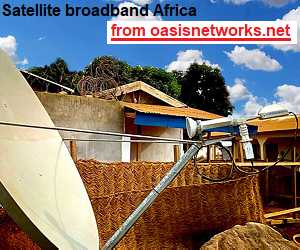| Home Login Register |
Satellite Internet forum
| Service Providers | Last Post | Topics | Posts |
|
LEO forum: OneWeb satellite constellation discussion Discussion forum about OneWeb low earth orbit (LEO) constellation of satellites Moderator: Admin1
|
Jan 8th, 2022 at 7:51pm In: The consequences of LEO s... |
8 | 11 | |
|
LEO forum: Starlink satellite service Starlink satellite internet service using a constellation of low earth orbit (LEO) satellites Moderator: Admin1
|
Mar 31st, 2023 at 2:30pm In: Starlink service : Lower... |
10 | 14 | |
|
LEO forum : Telesat Lightspeed project Constellation of 1000+ satellites using multi-beam phased array technology Moderator: Admin1
|
Jul 25th, 2023 at 12:48pm In: Optical Communications: T... |
3 | 3 | |
|
Satellite Internet - Americas Your news and discussion regarding satellite internet access in North and south America! Moderators: USN - Retired, Admin2
|
Sep 20th, 2021 at 9:35am In: Re: VSAT installers in th... |
265 | 1054 | |
|
Exede satellite broadband forum (was Wildblue) News, customer experience, advice: Exede satellite broadband service in the US and Telesat in Canada. Moderators: USN - Retired, Admin2
|
Mar 25th, 2020 at 10:00pm In: Re: Wildblue warning! |
84 | 377 | |
|
Satellite Connection in Africa Your news, views and discussion about communications in Africa! Moderators: Eric Johnston, USN - Retired, Admin2
|
Dec 7th, 2008 at 7:41pm In: Re: IS904 circular polari... |
1049 | 2651 | |
|
Satellite Internet - Europe Discuss satellite broadband services in Europe Moderators: Eric Johnston, USN - Retired, Admin2
|
Aug 29th, 2023 at 11:21am In: Re: BUC status |
222 | 768 | |
|
Avanti-Hylas Ka band services - EU, ME, Africa Forum about Avanti-Hylas satellite service in Europe, Mid East & Africa, plus steerable spot beams. Moderators: Admin1, USN - Retired, henry.james, Admin2
|
Jul 18th, 2022 at 3:49pm In: Re: Newtec Kit (1.0M/MDM2... |
83 | 146 | |
|
TooWay and KA-SAT satellite Forum for TooWay and KA-SAT satellite internet access system in Europe, Middle East and North Africa. Moderators: Eric Johnston, USN - Retired, Admin2, henry.james
|
Apr 10th, 2021 at 1:39pm In: Re: Unable to get the act... |
339 | 2118 | |
|
Satellite Internet - Middle East Your news and discussion about implementing satellite internet access in the Middle East! Moderators: USN - Retired, Maxim Usatov, Admin2
|
Oct 13th, 2022 at 6:27pm In: Cheap Dedicated Satellite... |
350 | 1052 | |
|
Satellite Internet - India, Asia and Australia Your news and discussion regarding satellite internet access in India, Asia and Australia! Moderators: Admin1, USN - Retired, Admin2
|
Jul 25th, 2023 at 11:35am In: India's Space Policy and... |
283 | 816 | |
|
Maritime and Mobile satellite communications Discussion forum for Maritime and Mobile satellite communications services Moderators: Admin1, USN - Retired, Admin2
|
Feb 1st, 2023 at 5:58pm In: Installation and repair o... |
71 | 128 |
| VSAT technology and installation | Last Post | Topics | Posts |
|
LinkStar Forum: VSAT hubs and terminals Your experiences and problems discussed Moderators: Admin1, USN - Retired, Admin2
|
Jul 7th, 2022 at 5:01pm In: Wanted: ViaSat Linkway S2... |
172 | 651 | |
|
HughesNet and Hughes HX VSATs Your experiences and problems discussed Moderators: USN - Retired, Admin2
|
Nov 29th, 2016 at 1:16pm In: Re: CRC error check |
320 | 1756 | |
|
iDirect Forum: hubs and terminals Discussion relating to iDirect VSAT hubs, networks and terminals Moderators: Admin1, USN - Retired, Admin2
|
Aug 8th, 2023 at 4:31am In: Re: Looking for Refurbish... |
926 | 4174 | |
|
Gilat VSAT Forum Discussion relating to Gilat VSAT hubs, networking and remotes Moderators: Admin1, USN - Retired, Admin2
|
Dec 4th, 2020 at 9:34am In: Wanted: Skyedge and Skyed... |
46 | 112 | |
|
Dish pointing and alignment Your experiences and problems discussed Moderators: Admin1, USN - Retired, Admin2
|
Apr 2nd, 2024 at 5:55pm In: Re: Bell satellite angles... |
445 | 1819 | |
|
Hub and VSAT satellite equipment for sale and wanted VSAT, BUC, LNB, terminals for sale and wanted. Please indicate location of the equipment for sale or location where the equipment is wanted. Moderators: Admin1, USN - Retired, Admin2
|
Apr 10th, 2024 at 3:19am In: Newly 4.5 Meter C & Ku Du... |
1150 | 1842 | |
|
Satellite dish installations - pictures and descriptions Please add here pictures and descriptions of satellite antennas, earth station teleports and VSAT dish installations. Moderators: Admin1, USN - Retired, Admin2
|
Yesterday at 11:03am In: Re: SatLink meter questio... |
114 | 196 |
| Anything else | Last Post | Topics | Posts |
|
Wireless Internet - WiFi and WiMax Wireless Internet and extending the reach of VSAT. WiFi 802.11, WiMax 802.16 Moderators: Admin1, USN - Retired, Admin2
|
Mar 4th, 2021 at 6:21pm In: BATS WiFi tracking antenn... |
83 | 211 | |
|
General and other topics How do we get prices down ? How much bandwidth is available ? Satellite versus terrestrial ? Moderators: Admin1, USN - Retired, Maxim Usatov, Admin2
|
Oct 26th, 2023 at 9:17am In: An article to understand... |
243 | 755 | |
|
Satellite transponder leasing and sales Buy or sell satellite transponder capacity - short and long term leases - whole transponders or fractional MHz leases. Moderators: Admin1, USN - Retired, Admin2
|
Dec 14th, 2022 at 1:24pm In: Re: Thaicom 5 to Broadcas... |
250 | 409 | |
|
Satcom jobs: Satellite communications jobs If you are seeking staff or want a job, you are welcome to advertise satcom job vacancies or your own availability here. Satellite manufacture, design, operator, service provider, engineering, sales, VSAT hubs and installers. Military. Civil. Moderators: Admin1, USN - Retired, Admin2
|
Sep 2nd, 2022 at 3:44pm In: Telecom engineer availabl... |
153 | 410 |
| Forum Statistics |
|
The forum contains a total of 21473 Posts within 6669 Topics.
The most recent post is Re: SatLink meter questions--Bell sats (Yesterday at 11:03am). View the most recent posts on the forum.
There are a total of 2615 registered members.
The newest member is barryc. |
|
|
The most users ever online was 1013 on Nov 11th, 2017 at 5:29pm.
The most members ever online was 7 on Jul 17th, 2013 at 9:00am. The most guests ever online was 1013 on Nov 11th, 2017 at 5:29pm. The most search engines ever online was 110 on Jun 17th, 2015 at 2:34pm. |
| Users Online |
|
Members: 0
Guests: 10 Search Engines: 0 lllll YaBB Admin lllll Global Moderator
|
| Login | |
Email me: eric@satsig.net
Powered by YaBB 2.5.2!
YaBB Forum Software © 2000-. All Rights Reserved.
Disclaimer, Terms of Use and Privacy Forum User Agreement Forum rules Cookie policy.


